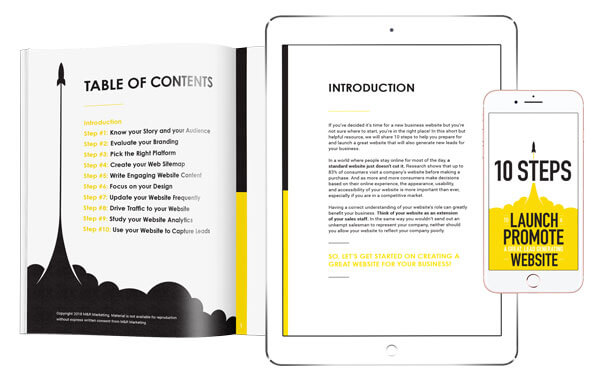
Have you ever looked back at family photos, maybe from a few Christmases ago, and wondered, “What on earth was I wearing?” Well, web design is a lot like family photos, or rather fashion. When it comes to what’s in-style, it changes… quickly.
On average, you should do a major evaluation of your website every 2-3 years, and that evaluation should consider your design, tech, content, and search engine ranking.
Today we’ll help you perform a four-point website evaluation and determine if a website redesign should be one of your goals.
Let’s start by thinking about your website and your evaluation in automotive terminology:
- Design is the exterior of your vehicle: How does it look? Is it dinged and dented or smooth and polished? Depending on your answer, it might be time for a paint job.
- Tech is the motor: Is it outdated and in need of a tune-up? Does it make funny noises when you try to drive it faster than 60 mph?
- Content are the wheels: Is your content flat and lumping along or do you have good momentum? Do you need to add some air to the tires?
- SEO ranking is your gas mileage: Is it dragging and losing performance or running efficiently? Will you be able to reach your destination, or will you become stranded on the side of the road?
Website Evaluation Step One: Design
The design or your website is the most obvious place to start—it’s a potential client’s first impression of your company.
Compare your website to similar websites within your industry. How does your website hold up—or does it? It’s also helpful to take a look at the websites of huge corporations. What design elements are they using? Why do you like the appearance of their websites?
Then, do some research to discover the designs that are in style. Here are a few big design changes that have occurred over the past couple of years:
- Full-width design: In the past, web design didn’t take advantage of the entire width of your screen. Now, with huge computer screens and beautiful retina displays, design has evolved to take up more real estate. Large photos or videos that stretch across the entire screen look awesome and are really eye-catching.
- Panel design: This type of design divides your content into horizontal sections, so that as someone scrolls down the page, the colors and images can change and keep them engaged. It’s more interesting than scrolling down a white page that keeps going and going and going…
- Hidden menus: You’re probably used to seeing a menu bar at the top of most of the websites you visit. Recently however, designers have been tucking the menu away in an unobtrusive corner so as not to distract from a company’s messaging.
Other areas to evaluate include:
- Images: Does your site entice potential clients by using large, striking images? On the flip side, are you overwhelming your customers by using too many images?
- Navigation: How easy is it to get to the most important pages of your website?
- Calls-to-action: Do you have one to two clear calls-to-action above the fold (the part of a webpage you can see before scrolling down)?
- Audio/video content: How can you include audio or videos on your website?
“The current trend is a minimalist look,” says our senior graphic designer Heather Waldron. “Minimalism is clean-looking, it features flat colors and solid shapes, and it caters to the user’s experience. People have short attention spans so your website’s design shouldn’t distract from your message. Instead, it should enhance your message.
Another aspect of website design that’s changed is that design can be a lot more creative than in the past. It’s more common to experiment with layouts and take risks.”
Sign Up For A Free Website Evaluation
Website Evaluation Step Two: Tech
From a technology standpoint, the biggest shift over the last 2-3 years was a movement to Responsive Website Design, which means your website will respond to fit all types of screen sizes, from small smartphone screens to large desktop screens.
As trends have continued to shift toward mobile, it has become increasingly necessary to have a strong, mobile friendly website. Google made a major splash when it announced last year that it would begin catering its search results based on the mobile functionality of websites.
Pick up your smart phone or tablet and go to your website. How does it look? Is it easy to use on your mobile device, or do you have to pinch and scroll in order to read tiny words and click on miniscule buttons?
Something else to consider is how well your website is converting leads. Contact forms, CTAs, and links to your social media platforms go a long way toward turning leads into customers.
“Businesses and organizations should consider whether or not it’s possible to find the information their clients need very quickly,” says Will Hawthorne, our senior web developer. “Your website needs to load instantly on every possible device, whether that’s a phone, tablet, laptop, or 27-inch Retina screen.”
Website Evaluation Step Three: Content
Carve out two to three hours to read every word of your website and ask yourself the following questions:
- What needs to be updated?
- How can you make your content easier to scan and digest?
- What questions are you most often asked, and are they answered in the content?
- What info is most important for a potential client, and is it in a prominent place on the website?
Your content is the area of your website that should be constantly changing through updating information, adding case studies and client testimonials, and writing a regular blog.
Blogging is one of the most important tools you can use in order to generate leads and sales. A regularly updated blog increases traffic to your site, improves your SEO, and sets you up as an authority within your industry.
A blog can improve your website traffic by up to 55%, and it can increase the number of inbound links to your website by up to 97%. Plus, 61% of consumers in the U.S. say they’ve made a purchase based on a blog. (Source)
Website Evaluation Step 4: Search Engine Ranking
Everything we’ve talked about so far can affect your search engine ranking, so an important part of your evaluation should include assessing your SEO strategy.
Google frequently changes the algorithm it uses to determine a site’s ranking, so it’s crucial to stay up-to-date about good SEO practices.
To evaluate your search engine ranking, start by Googling your company and services. What shows up in the results? If you’re not on the first page, or if your competitor ranks higher than you, then it’s time to take action.
Next, look at your social media profiles. How often do you post updates? Google and other search engines are beginning to take social media into account when ranking websites. If your last post on Facebook is from 2014, it’s time to establish a social media strategy.
Measure how quickly your website loads. Search engines and clients alike hate slow websites, so you might need to speed up your load time.
Now What?
Your website is one of the most important tools in your organization’s marketing and sales arsenal. If your website is outdated, chances are clients will think your whole company is outdated.
For a free website evaluation from M&R Marketing Group, give us a call at 478-621-4491 or email us at hey@mandr-group.com.
Never Miss An Article – Sign Up for Our Monthly eNewsletter!
Ready to Learn More About Launching a Great Website?


